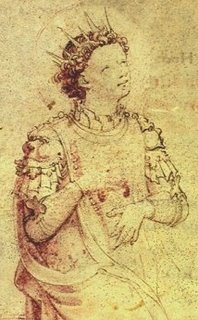 January 1, 2007 (New Year's Day)
January 1, 2007 (New Year's Day)Adoration of Magi, by unknown Chinese artist; period unknown.
At my church this morning, we elected to celebrate Epiphany Sunday. I thought it would be appropriate to share an Adoration of the Magi today. I wish I could find out more about this particular representation, and that it were of better quality.
I have a love-hate relationship with the carol "We Three Kings." First of all, the magi were not kings! Secondly, very few verse-refrain hymns remain interesting by the third or fourth time we sing the refrains. This one is a good example. (We sang it this morning, and sang the refrain only after the first and last verses. We also used a "brisk" rather than "stately" tempo, which helps a great deal.)
What I genuinely like about the carol, however, is what it has to teach us about the nature of the gifts the magi brought to the holy Child. Here are those interior verses:
"Born a king on Bethlehem's plain, gold I bring to crown him again;
King forever, ceasing never, over us all to reign.
"Frankincense to offer have I; incense owns a Deity nigh;
Prayer and praising, voices raising, worshiping God on high.
"Myrrh is mine; its bitter perfume breathes a life of gathering gloom;
Sorrowing, sighing, bleeding, dying, laid in the stone-cold tomb."
This carol is yet another reminder that the Christmas story is not pretty, neat, or sentimental. We Christians celebrate the coming of God, the Sovereign of the Universe, into human history. He was born like any other human being, but into poverty, violence, and political chaos. Christ did not come into the world in order to be a cute little baby we can cuddle for a few days each year, then forget about until it's time for Easter lilies. Mary's infant grew up to set his face toward Jerusalem and the cross that awaited him there. Baby Jesus was born to die. The King of Kings, whose coming was announced by the herald angel, would be mocked as "King of the Jews" just before his execution. And this King, God, and Sacrifice calls us with his eternal "Follow Me."
Am I willing to lay at the cradle of the little King the gold that I would prefer to hoard? The incense of prayer and praise as the God he is, when I find myself yet again on the throne of my own life? The anointing essence of the confession of my sin, that I may be crucified with him so that he lives in me?
Or will I merely sing, bored, about the star with royal beauty bright? Will I miss entirely the Savior to whom that star showed a band of determined Gentile astrologers the way so long ago?
Alleluia! Alleluia! Sounds through the earth and skies--and through me.
Side note:
In reviewing the past week's posts, I was struck by how exclusively Western European the art has been. It's been an education for me to hunt for good art which is in the public domain, in which Nativity themes portray non-European figures. There is a great deal of excellent work being done (and this is also true of North American and European art), but copyright issues make it illegal or unethical for me to post most of them here. In fact, I was careless about this with my post for December 25; I'll be removing the Ina Hecker icon detail in a few minutes and replacing it with something from the public domain.
If anyone reading this would like to suggest good Nativity-theme art for me to consider for the remainder of this series, I'd love to check out any links you may have.

1 comment:
Psalmist,
try Matt Stone's blog Journeys in Between: http://mattstone.blogs.com/
Scroll down a little, and on the right you will find quite a few non-European Jesus images.
Blessings in the new year-
Dana Ames
Post a Comment